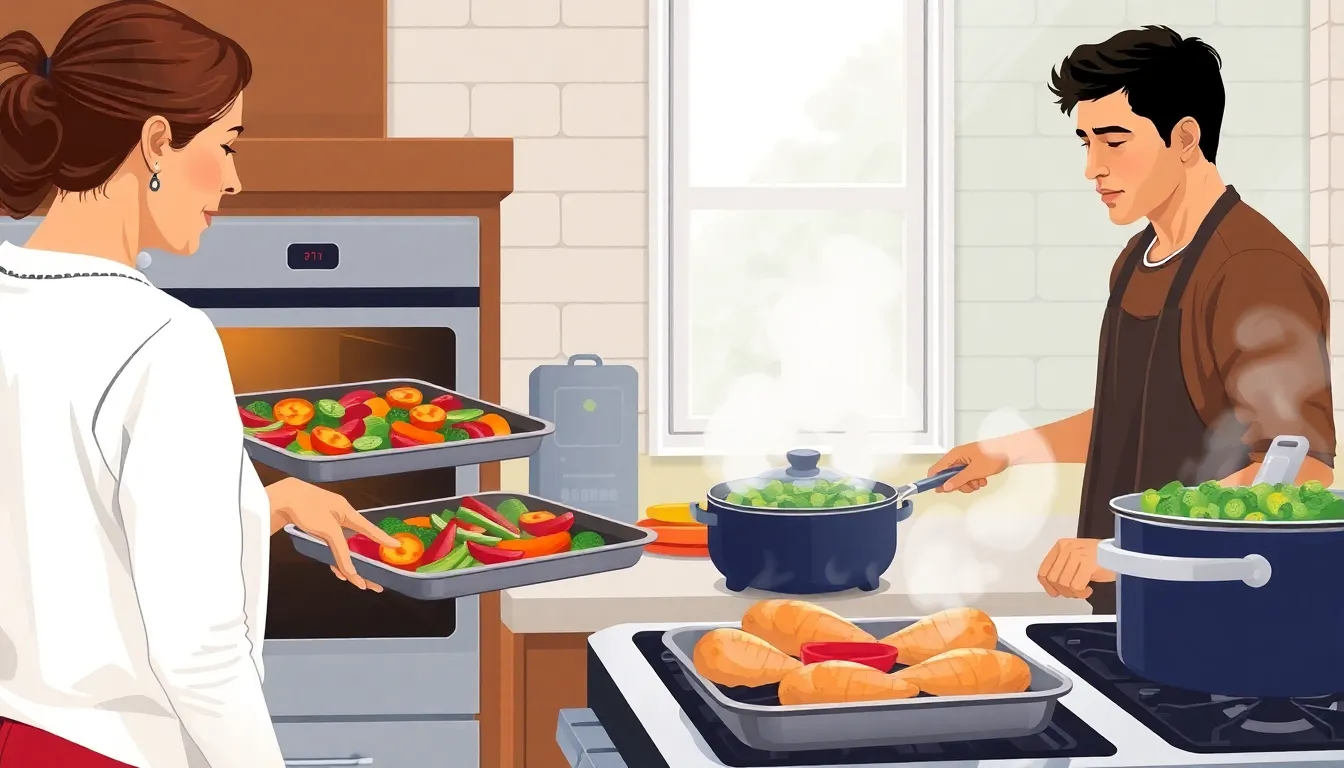Mastering the kitchen doesn’t require a culinary degree or a Michelin star. With a few basic cooking techniques, anyone can transform from a microwave magician to a kitchen wizard. Whether it’s sautéing vegetables or perfecting the art of boiling pasta, these essential skills can turn even the most reluctant cook into a culinary enthusiast.
Table of Contents
ToggleUnderstanding Basic Cooking Techniques
Basic cooking techniques establish a foundation for culinary skills. Sautéing involves cooking food quickly in a small amount of fat over relatively high heat, enhancing flavor and texture. Boiling, on the other hand, uses water or broth at high temperatures to cook ingredients evenly, ideal for pastas and vegetables.
Roasting brings a unique depth to dishes by using dry heat in the oven, usually perfect for meats and root vegetables. Grilling, another popular method, imparts a distinct char and smoky flavor, often used for steaks, vegetables, and seafood. Each technique serves specific purposes, contributing to diverse meal preparations.
Steaming cooks food by utilizing vapor from boiling water, retaining nutrients and moisture, which is excellent for vegetables and seafood. Baking differs slightly, using dry heat to cook food, commonly associated with breads, cakes, and casseroles. Additionally, braising combines both moist and dry heat, searing food first and then cooking it slowly in a small amount of liquid for tender results.
Stir-frying resembles sautéing but often uses a wok and requires rapid cooking, making it ideal for vegetables and thinly sliced meats. Each technique varies in cookware preferences, such as skillets for sautéing or a Dutch oven for braising, influencing the final dish. Transitioning from one technique to another allows flexibility, enabling the enhancement of flavors and textures in meals.
Grasping these basic cooking techniques equips individuals with essential skills to explore and enjoy the culinary world. Embracing the variety encourages creativity in the kitchen, leading to the preparation of delicious and satisfying meals.
Common Cooking Methods

Mastering cooking techniques involves understanding various methods. Familiarity with these methods enhances meal preparation and offers creativity in the kitchen.
Dry Heat Cooking
Dry heat cooking relies on hot air or direct flames to cook food. Roasting involves cooking meat and vegetables in an oven, allowing flavors to develop through caramelization. Grilling uses high heat to cook food over an open flame, providing a distinctive char and smoky taste. Baking typically refers to cooking foods like bread and pastries in an oven, focusing on even heat distribution. Sautéing cooks food quickly using a small amount of oil or fat in a pan, which seals in flavors while keeping ingredients tender.
Moist Heat Cooking
Moist heat cooking incorporates steam or boiling water to prepare food. Boiling cooks ingredients in water or broth, often used for pasta and vegetables. Steaming involves cooking over boiling water, preserving nutrients and flavors in fragile items such as fish or vegetables. Braising combines the benefits of moisture and heat, searing food first before slow cooking it in liquid. Poaching gently cooks delicate foods, like eggs or fruits, in barely simmering liquid, resulting in a tender texture. Each method serves unique purposes, ensuring diverse and delicious meal options.
Essential Cooking Tools
Essential cooking tools can significantly enhance culinary experiences. Equipping the kitchen with the right equipment simplifies food preparation and promotes efficiency.
Knives and Cutting Boards
Knives rank as fundamental kitchen tools. A chef’s knife, paring knife, and serrated knife each serve distinct purposes in food preparation. For instance, a chef’s knife excels at chopping and dicing vegetables, while a paring knife proves useful for intricate tasks like peeling fruits. Cutting boards, made from wood or plastic, provide a stable surface for cutting. Maintaining separate boards for raw meat and vegetables prevents cross-contamination. High-quality knives and durable cutting boards contribute to safety and precision in meal preparation.
Cookware and Utensils
Cookware encompasses a variety of essential pots and pans. A nonstick skillet ensures easy cooking and cleanup for everyday dishes. Stainless steel pots are ideal for boiling, simmering, or making sauces. Utensils such as spatulas, ladles, and tongs support various cooking techniques. Each utensil functions uniquely, enhancing the cooking process. Selecting the appropriate cookware and utensils makes meal preparation more enjoyable and efficient, allowing for creativity in the kitchen.
Tips for Mastering Basic Cooking Techniques
Mastering basic cooking techniques requires commitment and exploration. Each person develops skills at their own pace, benefiting from practice and patience.
Practice and Patience
Repeatedly practicing techniques enhances confidence. Understanding that mistakes occur during the learning journey helps maintain motivation. Gradual improvement emerges from experimenting with various methods, such as sautéing and boiling. Mastering each technique in different dishes allows cooks to adapt recipes with ease. Regularly cooking helps internalize these processes, making them second nature. Over time, individuals recognize their progress, turning simple actions into intuitive skills.
Recipes to Try
Trying a variety of recipes encourages flexibility with techniques. Begin with a classic tomato sauce for sautéing onions and garlic, providing a flavorful base. Move on to boiling pasta, a fundamental dish that serves multiple purposes. Explore roasting vegetables like carrots and bell peppers, highlighting dry heat methods. Incorporating grilled chicken into salads or wraps showcases versatility. By tackling these recipes, cooks gain valuable experience while honing their skills. Each recipe offers opportunities to refine techniques and inspires creativity in the kitchen.
Embracing basic cooking techniques opens the door to a world of culinary possibilities. With a solid foundation in essential methods individuals can elevate their cooking skills and discover new flavors. The right tools make the process smoother and more enjoyable fostering creativity in the kitchen.
As they practice and experiment with various recipes confidence will grow and cooking will become an exciting adventure. Each dish prepared is an opportunity to learn and refine skills. By committing to this journey anyone can transform their relationship with food and become a passionate cook ready to impress family and friends.




